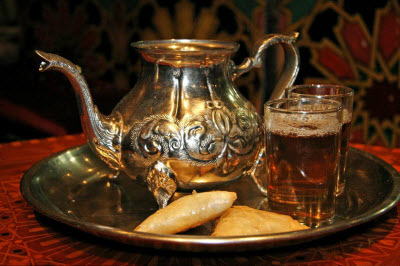Many years ago I had one of the most memorable dining experiences of my life and one that, as a tea drinker, has stayed with me decades past. It was a Moroccan restaurant serving up delicious foods. The most impressive thing, though, was the serving of the tea, so every once in a while I try pouring tea like a Moroccan waiter. The results are usually rather mixed.

Watching tea being poured can be a fairly wondrous sight. It is even taken to seemingly impossible heights, literally and figuratively, by professional tea pourers in Malaysia, Tunis, China, etc., who seek to amaze and entertain. The Moroccan waiter who poured my tea that evening long ago held the gleaming silver teapot up above his head and poured a thin stream of tea flawlessly from spout to tea glass with nary a drop going astray.
Okay, let’s see if I can do that. No silver teapots in this house, but plenty of others from which to choose. No Moroccan tea glasses, either, but we’ll make do with a couple of tall mugs that can take the heat, not to mention the force of the tea hitting them from on high. Now to make some authentic Moroccan style tea, starting with a nice green tea (one recipe I’ve seen calls for something named “Temple of Heaven,” a high-grade Chinese green tea). Optional additives are mint and sugar — you can leave them out, but the taste won’t be as authentic.
The process of making the tea is a bit complex. One method I’ve seen calls for three “washes” of the tea leaves. The first “wash” is kept aside and the 2nd and 3rd are thrown out. Then, that first “wash” is poured into a pot that can sit on the stove) with the “washed” tea leaves; then sugar and boiling water are added to the pot (sometimes the sugar is served on the side instead). This sits on the stove burner on low heat for 10 to 15 minutes. At this point, you can either add the mint to the tea in the pot or into the glasses before you pour in the tea.
So, my Moroccan style tea is ready and goes into the teapot. Time to pour. A Moroccan style teapot usually has — in addition to a long, curved spout — a hinged lid so that you don’t have this sudden “PLOP! CRASH!” as you are pouring the tea (somewhat nerve racking to say the least) or no lid at all. Not having such a hinged lid on my pot, I have to hold on the lid (porcelain/stoneware/glass, etc. are not tasty tea additives). Being rather new to this, I start out close to the glass and raise up the teapot, continuing to pour, as high as I can. Up…up…up…ah, all done! And no puddles on the counter or elsewhere.
Why go to all this trouble? First, because it’s just fun to try new things, especially related to tea. Second, because pouring from on high adds air into the tea and a bit of “foam” (just air bubbles) on the liquid’s surface, which looks attractive. Give it a try and serve up that foamy, minty tea with some Moroccan-style dishes such as couscous and spicy lamb with prunes and apricots. Dishes made with eggplant, lentils, tomatoes, and lemons are also Moroccan favorites and will go well with this tea. Enjoy!
Check out the Marrakesh Restaurant in Washington, D.C., to experience a tea pouring wonder.
© Online Stores, Inc., and The English Tea Store Blog, 2009-2014. Unauthorized use and/or duplication of this material without express and written permission from this article’s author and/or the blog’s owner is strictly prohibited. Excerpts and links may be used, provided that full and clear credit is given to Online Stores, Inc., and The English Tea Store Blog with appropriate and specific direction to the original content.



Leave a reply to Staying for Tea in Providence, Rhode Island « Tea Blog Cancel reply